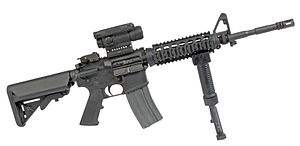
An M4 with Rail Adapter System (RAS), GRIPOD vertical forward grip and M68 CCO sight.
The M4 carbine is a family of firearms tracing its lineage back to earlier carbine versions of the M16 rifle, all based on the original AR-15 rifle designed by Eugene Stoner and made by ArmaLite. The M4 is a shorter and lighter variant of the M16A2 assault rifle, with 80% parts commonality.
It is a gas-operated, air-cooled, magazine-fed, selective fire, shoulder-fired weapon with a telescoping stock. A shortened variant of the M16A2 rifle, the M4 has a 14.5 in (370 mm) barrel, allowing its user to better operate in close quarters combat. The M4 has selective fire options including semi-automatic and three-round burst (like the M16A2 and M16A4), while the M4A1 has the capability to fire fully automatic instead of three-round burst (like the M16A1 and M16A3). The carbine is also capable of mounting an M203 grenade launcher (the M203A1 with a 9-inch barrel as opposed to the standard 12-inch barrel of the M203 used on the M16 series) as well as its successor, the M320 grenade launcher. The M4 carbine is a family of firearms tracing its lineage back to earlier carbine versions of the M16 rifle, all based on the original AR-15 rifle designed by Eugene Stoner and made by ArmaLite. The M4 is a shorter and lighter variant of the M16A2 assault rifle, with 80% parts commonality.
The M4 carbine is heavily used by the U.S military. It is slated to eventually replace the M16 rifle for most combat units in the United States Army. The winner of the Individual Carbine competition might supplement the M4 carbine in U.S. Army service. This is for the US Army only while all other services will continue to use the M4 carbine and M16 rifles.
History[]
Following the adoption of the M16, carbine variants were also adopted for close quarters operations. The CAR-15 family of weapons served through the Vietnam War. However, these carbines had design issues. They were primarily made for close ranges, like sub-machine guns, and so weapons like the XM177 "Commando" series suffered at longer ranges. In 1988, Colt began work on an new carbine design called the XM4 based on their M16A2 rifle. To remedy the range problem, Colt incorporated a 14.5 inch barrel, giving the weapon greater reach than the XM177 while still being more compact than the M16. The barrel was given the improved 1:7 inch rifle twist of the M16A2 to use the heavier 62 grain M855 rounds. The extended barrel gave the XM4 the ability to mount a shortened M203 grenade launcher. In 1994, the U.S. military officially accepted the XM4 into service as the M4 Carbine to replace the M3 Grease Gun, as well as selected M9 pistols and M16A2 rifles.
The United States Marine Corps has ordered its officers (up to the rank of lieutenant colonel) and Staff Non-commissioned officers to carry the M4 carbine instead of the M9 handgun. This is in keeping with the Marine Corps doctrine, "Every Marine a rifleman". The Marines however chose the full-sized M16A4 over the M4 as its standard infantry rifle. United States Navy corpsmen E5 and below will also be issued M4s instead of the M9.
The M4 has largely replaced the submachine gun in military use due to increased use of body armor, as SMGs firing pistol-power cartridges are unable to penetrate modern body armor.
Improved M4[]
On 1 July 2009, the U.S. Army took complete ownership of the M4 design. This will allow companies other than Colt to compete with their own M4 designs. The Army planned on fielding the last of its M4 requirement in 2010. On 30 October 2009, Army weapons officials proposed a series of changes to the M4 to Congress. Requested changes include an electronic round counter that records the number of shots fired, a heavier barrel, and possibly replacing the direct impingement system with a gas piston system. The benefits of this, however, have come under scrutiny from both the military and civilian firearms community. It should also be pointed out that, according to a PDF detailing the M4 Carbine improvement plans released by PEO Soldier, the direct impingement system will only be replaced after reviews are done comparing the direct impingement system to commercial gas piston operating system to find out and use the best available operating system in the US Army's improved M4A1.
In September 2010, the Army announced it will buy 12,000 M4A1s from Colt Firearms by the end of 2010, and will order 25,000 more M4A1s by early 2011. The Army announced also to have open competition for the newly designed M4 bolt carrier and gas piston operation system, which will be fitted to the newly bought M4A1 carbines. The service branch plans to buy 12,000 of these conversion kits in early 2011. In late 2011 the Army plans to buy 65,000 more conversion kits. From there the Army will decide if it will upgrade all of its M4s. On 21 April 2012, the US Army announced to begin purchasing over 120,000 M4A1 carbines to start reequipping front line units from the original M4 to the new M4A1 version. The first 24,000 will be made by Remington Arms Company. Additional purchases will be sought, but no number of weapons or any gun makers has yet be contacted. Remington is to produce the M4A1s from mid-2013 to mid-2014. After completion of that contract, it will be between Colt and Remington to produce over 100,000 more M4A1s for the US Army.
M4 Product Improvement Program[]
The M4 product improvement program (PIP) is the effort by the U.S. Army to modernize its fleet of M4 service rifles. Phase I consists of converting and replacing regular M4s with the M4A1 version. This variant of the rifle is fully automatic and has a heavier barrel, and is given ambidextrous fire controls. Phase II of the PIP explored developing a new bolt carrier. 11 designs were submitted. The competition was scheduled to conclude in summer 2013, but ended in April 2012. Over six months of testing revealed that the current bolt carrier assembly outperformed the competing designs, especially in the areas of reliability, durability, and high-temp and low-temp tests. Phase II also includes a competition for a free-floating forward rail assembly. The Army may award contracts to up to three finalists in early 2013, with the selection of a final winner in early 2014. If the Army determines that the winning rail system should be procured, delivery of new rail is anticipated by the summer of 2014. Phase I of the M4 PIP is to be completed by 2017.
Future replacement[]
The carbine variant of the XM8 rifle was cancelled in 2005.
On 13 November 2008, the U.S. Army hosted an Invitation-only Industry Day regarding a potential future replacement for the M4 carbine. Nineteen companies provided displays and briefings for military officials. The weapons displayed included the Barrett REC7 PDW, Remington ACR, FN SCAR, Heckler & Koch HK416, Heckler & Koch XM8, LWRC M6A4, Robinson Arms XCR, SIG 556, as well as Colt's own improved version of the M4, the Colt ACC-M. The goal of the Industry Day was to provide officials with knowledge as to the current state of the art, which will assist the writing of a formal requirements document.
The possible successor to the M4 carbine in the U.S. Army is the Individual Carbine. This program is to provide a new carbine for the Army, while the USMC has decided to stay with the M4 for carbine use.
Design[]
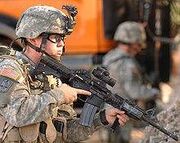
M4 with M68 Close Combat Optic and AN/PAQ-4.
The M4 and its variants fire 5.56x45mm NATO ammunition (and .223 Remington ammunition) and are gas-operated, air-cooled, magazine-fed, selective fire firearms with either a multi-position telescoping stock or a fixed A2 or LE tactical stock. Original M4 models had a flat-ended telescoping stock, but newer models are now equipped with a redesigned telescoping stock that is slightly larger with curvature at the end. The M4 is similar to much earlier compact M16 versions, such as the 1960s-era XM177 family. Some of those visual designs are obvious in both weapons, however most of the similarities are not very noticeable.
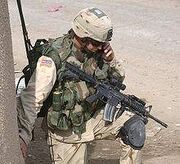
The M4 with the newer, redesigned telescoping stock.
As with many carbines, the M4 is handy and more convenient to carry than a full-length rifle. The price is slightly inferior ballistic performance compared to the full-size M16, with its nearly 6" (15 cm) longer barrel. This becomes most apparent at ranges of 300 yards and beyond. Statistically, however, most small-arms engagements occur within 100 yards. This means that the M4 is very much an adequate weapon for the majority of troops. The marginal sacrifice in terminal ballistics and range, in exchange for greatly improved handling characteristics, is usually thought to be a worthwhile compromise. A very large proportion of US forces engagements in the recent middle-east conflicts has consisted of MOUT, therefore justifying the choice.
While the M4's maneuverability makes it a candidate for non-infantry troops (vehicle crews, clerks and staff officers), it also makes it ideal for close quarters battle (CQB). The M4 was developed and produced for the United States government by Colt Firearms, which had an exclusive contract to produce the M4 family of weapons through 2009; however, a number of other manufacturers offer M4-like firearms. The M4, along with the M16A4, have mostly replaced the M16A2 in the Army and Marines. The U.S. Air Force, for example, has transitioned completely to the M4 for Security Forces squadrons, while other armed personnel retain the M16A2. The US Navy uses M4A1s for Special Operations and by vehicle crews.
Some features of the M4 and M4A1 compared to a full-length M16-series rifle include:
- Compact size
- Shortened barrel 14.5 in (370 mm), which includes the shorter carbine gas system.
- Telescoping buttstock
However, there have been some criticisms of the carbine, such as lower muzzle velocities and louder report due to the shorter barrel, additional stress on parts because of the shorter gas system, and a tendency to overheat faster than the M16A2.
Accessories[]
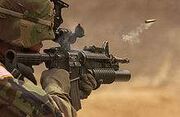
An M4A1 just after firing, with an ejected case in mid-air; the M203 and M68 CCO are attached.
Like all the variants of the M16, the M4 and the M4A1 can be fitted with many accessories, such as night vision devices, suppressors, laser pointers, telescopic sights, bipods, either the M203 or M320 grenade launchers, the [[M26 Modular Accessory Shotgun System |M26 MASS shotgun]], forward hand grips, and anything else compatible with a MIL-STD-1913 Picatinny rail.
Other common accessories include the AN/PEQ-2, Advanced Combat Optical Gunsight (ACOG), and M68 CCO. EOTech holographic weapon sights are part of the SOPMOD II package. Visible and IR (infrared) lights of various manufacturers are also commonly attached using various mounting methods. As with all versions of the M16, the M4 accepts a blank-firing attachment (BFA) for training purposes.
Feedramps[]
M4 feedramps are extended from the barrel extension into the upper receiver. This can help alleviate feeding problems which may occur as a result of the increased pressure of the shortened gas system of the M4. This problem is primarily seen in full-auto applications.
SOPMOD Block I[]
USSOCOM developed the Special Operations Peculiar Modification (SOPMOD) Block I kit for the carbines used by units under its jurisdiction. The kit features an M4A1, a Rail Interface System (RIS) handguard developed by Knight's Armament Company, a shortened quick-detachable M203 grenade launcher and leaf sight, a KAC sound suppressor, a KAC back-up rear sight, an Insight Technologies AN/PEQ-2A visible laser/infrared designator, along with Trijicon's ACOG and Reflex sights, and a night vision sight. This kit was designed to be configurable (modular) for various missions, and the kit is currently in service with special operations units.
SOPMOD Block II[]
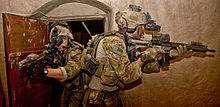
M4A1 SOPMOD Block II in Afghanistan 2012.
A second-generation SOPMOD kit (now known as SOPMOD II) includes innovative optics, such as the Elcan Specter DR and the Eotech 553. Block II uses the RIS II rails manufactured by Daniel Defense in both a 9.5 and 12.5 length.
Variants[]
Except for the very first delivery order, all U.S. military-issue M4 and M4A1 carbines possess a flat-top NATO M1913-specification (Picatinny) rail on top of the receiver for attachment of optical sights and other aiming devices — Trijicon TA01 and TA31 Advanced Combat Optical Gunsights (ACOG), EOTech 550 series holographic sights, and Aimpoint M68 Close Combat Optic (M68 CCO) being the favorite choices — and a detachable rail-mounted carrying handle. Standards are the Colt Model 920 (M4) and 921 (M4A1).
Variants of the carbine built by different manufacturers are also in service with many other foreign special forces units, such as the Australian Special Air Service Regiment (SASR). While the SASR uses weapons of essentially the same pattern built by Colt for export (Colt uses different models to separate weapons for the U.S. military and those for commercial/export purposes), the British SAS uses a variant on the basic theme, the Colt Canada (formerly Diemaco) C8SFW.
M4 MWS (Modular Weapon System)[]
Colt Model 925 carbines were tested fitted with the Knight's Armament Corporation (KAC) M4 RAS under the designation M4E2, but this designation appears to have been scrapped in favor of mounting this system to existing carbines without changing the designation. The U.S. Army Field Manual specifies for the Army that adding the Rail Adapter System (RAS) turns the weapon into the M4 MWS or Modular Weapon System.
M4A1[]
The M4A1 carbine is a fully automatic variant of the basic M4 carbine intended for special operations use. The M4A1 has a "S-1-F" (safe/semi-automatic/fully automatic) trigger group, while the M4 has a "S-1-3" (safe/semi-automatic/3-round burst) trigger group. The M4A1 is used by almost all U.S special operation units including, but not limited to, the Army Rangers, Army Special Forces, Navy SEALs and Air Force Combat Control Teams. The M4A1 is especially favored by counter-terrorist and special forces units for close quarters combat because of the carbine's compactness and firepower. These features are also very useful in urban warfare. It has a maximum effective range of about 500 to 600 meters (550–660 yd).
All U.S. Army forces will begin replacing their basic M4 carbines and all 600,000 M16 rifles with the M4A1 variant in 2014. The M4A1 in turn would likely be replaced with the Individual Carbine. Replacement of the M16 would come from the Individual Carbine instead of the M4A1 if procurement was attained.
In the last few years, M4A1 carbines have been refit or received straight from factory with barrels with a thicker profile under the handguard. This is for a variety of reasons such as heat dissipation, which is useful due to the complaints of high-heat production from test soldiers, which occurs during full-auto and accuracy as a byproduct of barrel weight. These heavier barrel weapons are also fitted with a heavier buffer known as the H2. Out of three sliding weights inside the buffer, the H2 possesses two tungsten weights and one steel weight, versus the standard H buffer, which uses one tungsten weight and two steel weights. These weapons, known by Colt as the Model 921HB (for Heavy Barrel), have also been designated M4A1, and as far as the government is concerned the M4A1 represents both the 921 and 921HB.
Mark 18 CQBR[]

An M4A1 with a Close Quarter Battle Receiver. The barrel length is 10.3 inches.
The Mk 18 Close Quarters Battle Receiver is an M4A1 with a 10.3" barrel upper receiver. Current contractor for the Mark 18 is Colt and Lewis Machine & Tool (LMT) NSN 1005-01-527-2288.
Enhanced M4[]
For the Individual Carbine competition, Colt has submitted an enhanced M4 design, also known as the Colt Advanced Piston Carbine (APC). The weapon has a suppression ready fluted barrel, which is lighter and cools better than current M4 barrels. It is claimed to have "markedly better" accuracy. To improve reliability, Colt used an articulating link piston which "reduces the inherent stress in the piston stroke by allowing for deflection and thermal expansion."
Performance[]
The M4 Carbine has been used for close quarters operations where the M16 would be too long and bulky to use effectively. It has been admired for being a compact, light, customizable, and accurate weapons platform. This has come at the cost of reliability and maintainability. Failure to maintain the M4 causes malfunctions. This became apparent as it saw countinued use in the sandy environments of Iraq and Afghanistan. Despite this, soldiers who keep their M4s clean and functioning find it to be an exceptional carbine. In post-combat surveys, 94 percent of soldiers rated the M4 as an effective weapons system.
2007 dust test[]
In the fall 2007, the Army tested the M4 against three other carbines in "sandstorm conditions" at Aberdeen Proving Ground, Maryland: the Heckler & Koch XM8, Fabrique Nationale de Herstal SOF Combat Assault Rifle (SCAR) and the Heckler & Koch HK416. Ten of each type of rifle were used to fire 6,000 rounds each, for a total of 60,000 rounds per rifle type. The M4 suffered far more stoppages than its competitors: 882 stoppages, 19 requiring an armorer to fix. The XM8 had the fewest stoppages, 116 minor stoppages and 11 major ones, followed by the FN SCAR with 226 stoppages and the HK416 with 233. The Army was quick to point out that even with 863 minor stoppages—termed "class one" stoppages which require 10 seconds or less to clear and "class two" stoppages which require more than ten seconds to clear—the M4 functioned well, with over 98 percent of the 60,000 total rounds firing without a problem. The Army said it planned to improve the M4 with a new cold-hammer-forged barrel to give longer life and more reliable magazines to reduce the stoppages. Magazine failures caused 239 of the M4's 882 failures. Army officials said the new magazines could be combat-ready by spring if testing went well.
Gas Piston[]
Complicating the Army search for higher reliability in the M4 is a number of observations of M4 gas piston alternatives that suffer unintended design problems. The first is that many of the gas piston modifications for the M4 isolate the piston so that piston jams or related malfunction require the entire weapon be disassembled, such disassembly cannot be performed by the end user and requires a qualified armorer to perform out of field, whereas any malfunction with the direct-impingement system can be fixed by the end user in field. The second is that gas piston alternatives use an off-axis operation of the piston that can introduce carrier tilt, whereby the bolt carrier fails to enter the buffer tube at a straight angle resulting in part wearing. The third is that the use of a sound suppressor results in hot gases entering the chamber, regardless of a direct-gas impingement or gas piston design choice. The gas-piston system also causes the firearm to become proprietary to the manufacturer, making modifications and changes with parts from other manufacturers difficult. The argument for a gas piston is that it would reduce fouling; while the argument against it is that it would increase weight and reduce accuracy.
Despite arguments defending the traditional direct-impingement system, the Enhanced M4 uses an articulating link piston operating system.
Trademark issues[]
Colt previously held a U.S. trademark on the term "M4". Many manufacturers have production firearms that are essentially identical to a military M4, but with a 16" barrel. Civilian models are sometimes colloquially referred to as "M4gery" ( /ɛmˈfɔərdʒəri/, a portmanteau of "M4" and "forgery"). Colt had maintained that it retains sole rights to the M4 name and design. Other manufacturers had long maintained that Colt had been overstating its rights, and that "M4" had now become a generic term for a shortened AR-15. In April 2004, Colt filed a lawsuit against Heckler & Koch and Bushmaster Firearms, claiming acts of trademark infringement, trade dress infringement, trademark dilution, false designation of origin, false advertising, patent infringement, unfair competition, and deceptive trade practices. Heckler & Koch later settled out of court, changing one product's name from "HK M4" to "HK416". However, on December 8, 2005, a District court judge in Maine granted a summary judgment in favor of Bushmaster Firearms, dismissing all of Colt's claims except for false advertising. On the latter claim, Colt could not recover monetary damages. The court also ruled that "M4" was now a generic name, and that Colt's trademark should be revoked.
U.S. citizen ownership[]
Sales of select-fire or full automatic M4s by Colt are restricted to military and law enforcement agencies. Only under special circumstances can a private citizen own an M4 in a select-fire or fully automatic configuration. While many machine guns can be legally owned with a proper tax stamp from the Bureau of Alcohol, Tobacco, Firearms and Explosives, an amendment to the Firearm Owners Protection Act of 1986 barred the transfer to private citizens of machine guns made or registered in the U.S. after May 19, 1986. The only exception was for Special Occupational Taxpayers (SOT): licensed machine gun dealers with demonstration letters, manufacturers, and those dealing in exports and imports. As such, only the earliest Colt M4 prototypes built prior to May 19, 1986 would be legal to own by civilians not in the categories mentioned.
Civilian replicas of the M4 (commonly called M4geries) have 16 inch barrels and are semi-automatic only to meet the legal definition of a rifle under Title I (Gun Control Act). The M4 falls under restrictions of Title II (National Firearms Act: the 14.5 inch barrel makes the M4 a Short Barrel Rifle (SBR) and select fire capability (semi- or full automatic) makes the M4 a machinegun. Civilian-legal M4geries are also popular with police as a patrol carbine, partly because the M4 is subject to more restriction.